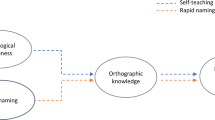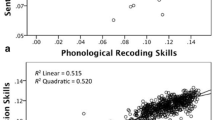Abstract
Linguistic knowledge, cognitive ability, and instruction influence how adults acquire a second orthography yet it remains unclear how different forms of instruction influence grain size sensitivity and subsequent decoding skill and speed. Thirty-seven monolingual, literate English-speaking adults were trained on a novel artificial orthography given initial instruction that directed attention to either large or small grain size units (i.e., words or letters). We examined how initial instruction influenced processing speed (i.e., reaction time (RT)) and sensitivity to different orthographic grain sizes (i.e., rimes and letters). Directing attention to large grain size units during initial instruction resulted in higher accuracy for rimes, whereas directing attention to smaller grain size units resulted in slower RTs across all measures. Additionally, phonological awareness skill modulated early learning effects, compensating for the limitations of the initial instruction provided. Collectively, these findings suggest that when adults are learning to read a second orthography, consideration should be given to how initial instruction directs attention to different grain sizes and to inherent phonological awareness ability.





Similar content being viewed by others
References
Baayen, R. H., Piepenbrock, R., & Van Rijn, H. R. (1993). The {CELEX} lexical data base on {CD-ROM}.
Ball, E. W., & Blachman, B. A. (1991). Does phoneme awareness training in kindergarten make a difference in early word recognition and developmental spelling. Reading Research Quarterly, 26, 49–66.
Bishop, C. H. (1964). Transfer effects of word and letter training in reading. Journal of Verbal Learning and Verbal Behavior, 3, 215–221.
Bitan, T., & Karni, A. (2003). Alphabetical knowledge from whole words training: Effects of explicit instruction and implicit experience on learning script segmentation. Cognitive Brain Research, 16, 323–337.
Bitan, T., & Karni, A. (2004). Procedural and declarative knowledge of word recognition and letter decoding in reading an artificial script. Cognitive Brain Research, 19, 229–243.
Bitan, T., Manor, D., Morocz, I. A., & Karni, A. (2005). Effects of alphabeticality, practice and type of instruction on reading an artificial script: an fMRI study. Cognitive Brain Research, 25, 90–106.
Bradley, L., & Bryant, P. E. (1983). Categorizing sounds and learning to read—A causal connection. Nature, 301, 419–521.
Brooks, L., & Miller, A. (Eds.). (1979). A comparison of explicit and implicit knowledge of an alphabet (Vol. 1). New York: Plenum Press.
Detey, S., & Nespoulous, J. L. (2008). Can orthography influence second language syllabic segmentation? Japanese epenthetic vowels and French consonantal clusters. Lingua, 118(1), 66–81.
Erlam, R. (2005). Language aptitude and its relationship to instructional effectiveness in second language acquisition. Language Teaching Research, 9, 147–171.
Farrington-Flint, L., Wood, C., Canobi, K. H., & Faulkner, D. (2004). Patterns of analogical reasoning among beginning readers. Journal of Research in Reading, 27, 226–247.
Foorman, B. R., Francis, D. J., Fletcher, J. M., Schatschneider, C., & Mehta, P. (1998). The role of instruction in learning to read: Preventing reading failure in at-risk children. Journal of Educational Psychology, 90, 235.
Goswami, U. (1999). Causal connections in beginning reading: The importance of rhyme. Journal of Research in Reading, 22, 217–240.
Goswami, U., & Bryant, P. E. (1990). Phonological skills and learning to read. Hillsdale, NJ: Erlbaum.
Grainger, J. (1990). Word-frequency and neighborhood frequency-effects in lexical decision and naming. Journal of Memory and Language, 29(2), 228–244.
Hamada, M., & Koda, K. (2008). Influence of first language orthographic experience on second language decoding and word learning. Language Learning, 58, 1–31.
Hamada, M., & Koda, K. (2011). Similarity and difference in learning L2 word-form. System, 39(4), 500–509.
Harrington, M., & Sawyer, M. (1992). L2 working memory capacity and L2 reading skill. Studies in Second Language Acquisition, 14, 25–38.
Knafle, J. D., & Legenza, A. (1978). External generalizability of inquiry involving artificial orthography. American Educational Research Journal, 15, 331–347.
Koda, K. (1997). Orthographic knowledge in L2 lexical processing: a cross-linguistic perspective. In J. Coady & T. Huchin (Eds.), Second language vocabulary acquisition (pp. 35–52). England: Cambridge University Press.
Koda, K. (1999). Development of L2 intraword orthographic sensitivity and decoding skills. Modern Language Journal, 83, 51–64.
Laufer, B. (1997). What’s in a word that makes it hard or easy: some intralexical factors that affect the learning of words. In N. Schmitt & M. McCarthy (Eds.), Vocabulary: Description, acquisition and pedagogy (pp. 140–155). England: Cambridge University Press.
Medler, D. A. & Binder, J. R. (2005). MCWord: An on-line orthographic database of the English language. http://www.neuro.mcw.edu/mcword/.
Muljani, D., Koda, K., & Moates, D. R. (1998). The development of word recognition in a second language. Applied Psycholinguistics, 19, 99–113.
Nokes, T. J., & Ash, I. K. (2010). Investigating the role of instructional focus in incidental pattern learning. Journal of General Psychology, 137, 84–113.
Peterson, M. E., & Haines, L. P. (1992). Orthographic analogy training with kindergarten children: Effects on analogy use, phonemic segmentation, and letter-sound knowledge. Journal of Reading Behavior, 24, 109–127.
Skehan, P. (1991). Individual differences in second language learning. Studies in Second Language Acquisition, 13, 275–298.
Sparks, R. L., Patton, J., Ganschow, L., & Humbach, N. (2009). Long-term crosslinguistic transfer of skills from L1 to L2. Language Learning, 59, 203–243.
Sparks, R. L., Patton, J., Ganschow, L., & Humbach, N. (2012). Do L1 reading achievement and L1 print exposure contribute to the prediction of L2 proficiency? Language Learning, 62, 473–505.
Tomasello, M. (2003). Constructing a language: A usage-based theory of language acquisition. Cambridge, MA: Harvard University Press.
Tong, F. H., Irby, B. J., Lara-Alecio, R., & Mathes, P. G. (2010). Hispanic english learners’ responses to longitudinal english instructional intervention and the effect of gender: A multilevel analysis. Elementary School Journal, 110, 542–566.
Torgesen, J. K., Wagner, R. K., & Rashotte, C. A. (1999). Test of word reading efficiency (TOWRE). Austin, TX: Pro-Ed.
Van Orden, G. C., Stone, G. O., & Pennington, B. F. (1990). Word identification in reading and the promise of subsymbolic psycholinguistics. Psychological Review, 97, 488–522.
Vitevitch, M. S., & Luce, P. A. (2004). A web-based interface to calculate phonotactic probability for words and nonwords in English. Behavior Research Methods, Instruments, and Computers, 36, 481–487.
Wagner, R. K., & Torgesen, J. K. (1987). The nature of phonological processing and its causal role in the acquisition of reading skills. Psychological Bulletin, 101, 192–212.
Wagner, R. K., Torgesen, J. K., & Rashotte, C. A. (1999). Comprehensive test of phonological processing: CTOPP. Pro-Ed.
Walton, P. D. (1995). Rhyming ability, phoneme identity, letter-sound knowledge, and the use of orthographic analogy by prereaders. Journal of Educational Psychology, 87, 587–597.
Walton, P. D., Walton, L. M., & Felton, K. (2001). Teaching rime analogy or letter recoding reading strategies to prereaders: Effects on prereading skills and word reading. Journal of Educational Psychology, 93, 160–180.
Wise, B. W., Olson, D. K., & Treiman, R. (1990). Subsyllabic units as aids in beginning reader’s word learning: Onset-rime versus post-vowel segmentation. Journal of Experimental Child Psychology, 49, 1–19.
Woodcock, R. W., McGrew, K. S., & Mather, N. (2001). Woodcock-Johnson III tests of cognitive abilities. Riverside Pub.
Ziegler, J. C., & Goswami, U. (2005). Reading acquisition, developmental dyslexia, and skilled reading across languages: A psycholinguistic grain size theory. Psychological Bulletin, 131, 3–29.
Acknowledgments
The first author was partially funded by the Ruth L. Kirschstein NRSA Institutional Research T32 Training Grant from the NIDCD (T32 DC009399-01A10) to The Roxelyn and Richard Pepper Department of Communication Sciences and Disorders.
Author information
Authors and Affiliations
Corresponding author
Appendix
Appendix
All pseudowords used in training and generalization testing including English spelling (not trained, only used for creation of stimuli), pronunciation in IPA, and artificial orthographic pattern.

Rights and permissions
About this article
Cite this article
Brennan, C., Booth, J.R. Large grain instruction and phonological awareness skill influence rime sensitivity, processing speed, and early decoding skill in adult L2 learners. Read Writ 28, 917–938 (2015). https://doi.org/10.1007/s11145-015-9555-2
Published:
Issue Date:
DOI: https://doi.org/10.1007/s11145-015-9555-2




